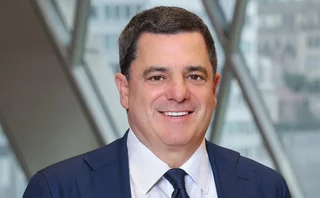
Prime broker of the year: BNP Paribas
Risk Awards 2023: Prêt-à-porter approach to acquiring ready-made businesses helps fashion top PB shop

It’s been a dazzling ascent. Since its 2008 purchase of Bank of America’s prime brokerage business, BNP Paribas has cut its cloth according to its plan – to become a top-ranked contender – by buying an armful of existing PB business off-the-peg.
As recently as 2019, BNP Paribas’s prime brokerage was seen as a mid-tier business, unlike those of its prominent European rivals, or the top-tier US houses like Goldman Sachs and Morgan Stanley.
But, in July of that year, it made the bold move to acquire Deutsche Bank’s electronic equities execution and prime services business. What followed was one of the largest integration projects ever seen in prime brokerage, with more than 100 clients and 1,000 staff transferring to the French bank over the subsequent two years.
Then it doubled down. In July 2021, the firm acquired the extant 50% stake it needed to fully own Exane, the European equities execution and research house. And when Credit Suisse decided to exit prime services after the collapse of Archegos Capital Management, the Swiss bank agreed to refer its clients to BNPP. The Deutsche deal was completed in November that same year.
The three deals transformed the business. They made BNP Paribas not only the largest European prime broker, but one that can challenge the US banks on their home turf. Since that first acquisition in 2008, buying established businesses off-the-shelf has proven to be the BNPP prime brokerage team’s route to the top.
“This is the first year that BNPP has operated on this scale on its own, and it’s been very successful,” says Ashley Wilson, global head of prime services at BNP Paribas.
Those [deals] really focused the attention of our largest clients. They recognised our ambition had genuine credibility
Ashley WIlson, BNP Paribas
Wilson, who previously ran Deutsche’s prime brokerage unit, says the deals were complementary. The Deutsche acquisition gave BNPP a risk and execution platform that was highly rated by quant funds, while Exane bolstered the offering to discretionary long/short equity funds. The Credit Suisse client referrals then allowed the business to scale up quickly.
“Those [deals] really focused the attention of our largest clients,” says Wilson. “They recognised our ambition had genuine credibility.”
In what was a tough year for equity hedge funds, BNPP managed to grow revenues in its equities and prime services unit by 25% to around $2.7 billion, as of the end of September 2022. In the third quarter alone, revenues in the division more than doubled in comparison to the same quarter in 2019.
According to revenue data from Coalition Greenwich and internal balance data, since signing the Deutsche transaction at the end of 2019, BNP Paribas’s prime brokerage platform has seen revenue and financing balances grow at a compound annual growth rate in excess of 35%.
“The prime brokerage business has received significant backing from the board and senior management, which have devoted significant resources and balance sheet to grow its prime services offering to rival its top US competitors,” says Wilson.
This past year, the bank has added complementary capabilities that will help sustain its prime brokerage ambitions. It devised a way to cross-margin bond repos with offsetting futures – a useful addition for macro funds doing basis trades.
The business has also been providing financing for special purpose acquisition companies (SPACs) and asset-backed securities (ABS) – a move popular with multi-strategy funds – and in 2022 it launched a joint venture with the firm’s credit business to provide financing for corporate debt assets.
All of which means BNPP can cover all the main hedge fund strategies – quant and discretionary equity long/short, macro, credit and multi-strategy funds – through its newly bolstered business.
Seamless
Completion of the Deutsche Bank migration involved the merger of BNP Paribas’s legacy prime brokerage platform with Deutsche’s two proprietary systems – its risk management platform, DBX Margin, and the Equity Swaps System (ESS). ESS was widely regarded as one of the most highly rated platforms by the industry, being able to process thousands of swaps transactions a day for single-name and non-single-name equities, as well as fixed income securities.
DBX Margin – the dynamic margin risk management system – came into its own in 2021 during the collapse of Archegos, when Deutsche Bank largely escaped unscathed. It was one of the few banks with direct exposure to the family office to do so.
“Very early on in the migration project, the decision was made collectively to migrate the DB risk margin technology to make it one strategic platform,” says Kam Singh, global head of BNPP’s prime services risk, and another Deutsche alumnus. “This consists of intraday portfolio monitoring, daily stress-testing and end-of-day risk attributes. We now have one single margin engine on the platform that covers all clients, both those that migrated across from DB and the legacy BNP Paribas clients.”
The addition of Deutsche’s risk technology gives added flavour to BNPP’s already-astute framework. For example, its dynamic margin framework can automatically adjust to risks in a client’s portfolio, while its intraday stress tests apply large shocks to the portfolio and enable them to look at the effect of multiple extreme events in an efficient, compact way, identifying pockets of risk. “The way we do this on a daily basis allows us to pick up idiosyncratic risks,” says Singh. “The tools we have allow us to proactively manage risk and the dynamic margin methodology adjusts on the portfolio risk as it becomes skewed.”
But the risks of completing the transaction on such a large scale – with a client base that is quick to react – were high. The project’s success hinged on ensuring continuity of service during the integration of the two systems with little-to-no impact on clients.
The tools we have allow us to proactively manage risk and the dynamic margin methodology adjusts on the portfolio risk as it becomes skewed
Kam Singh, BNP Paribas
Client feedback suggests BNP Paribas managed to pull it off without a hitch. “This was the biggest boost to their platform,” says one client at a large US hedge fund. “We have some nuances in terms of financing and margining our business. The legacy Deutsche Bank systems were very useful tools, and having BNP successfully migrating them into their portfolio definitely enhances their capabilities as a prime broker.”
Furthermore, the referrals from Credit Suisse have also expanded BNPP’s reach. Wilson says they have onboarded both former cash and synthetic prime brokerage clients of the Swiss bank, growing its prime balances to the tune of between $10 billion and $20 billion. He notes, however, that this did not happen overnight, and required them to update their platform to ensure they could take on the increased business. It held back in onboarding one US-based client until Q4 2022, for example, to make a specific development to its swaps platform that would accommodate the client’s operational requirements relative to Asia-based underliers.
“When CS announced they were exiting the prime services business, we [asked] some clients to give us another few months so we could build out our platform to take on their balances,” says Wilson. “So they did go elsewhere until we were ready.”
And BNPP did not open the floodgates for all former Credit Suisse clients. They had their own strict requirements that clients had to meet to avoid a repeat of another Archegos-style collapse. Hedge funds that previously adhered to a static margin framework, for example – which ultimately led to the downfall of Credit Suisse’s prime brokerage business – had to agree to BNP Paribas’s dynamic margining framework.
“The last thing we wanted was to onboard a load of business and then have a systems collapse – we wanted to do it in a safe environment,” says Wilson.
The right fit
The Deutsche deal has bolstered BNPP’s existing capabilities for macro fund clients and more complex, illiquid assets. It has provided the bank with an enhanced equities financing solution that features the combination of Exane with the former Deutsche electronic equities execution business. This gives the French bank the opportunity to expand its penetration with a greater range of clients across multiple asset classes.
“From the DB project, the entire electronic equities trading business covering algos, programme trading, low-latency, direct market access has successfully been integrated with the Exane execution capabilities and their best-in-class algo suite,” explains Oliver Jacomb, head of prime brokerage sales, Emea, for BNP Paribas. “Where we see that business going forward is expanding those relationships with quant funds and equity long/short clients globally.”
For macro funds, the firm has developed a solution to cross-margin a bond repo with an offsetting futures exposure, with the prime brokerage business acting as the collateral agent. This is particularly useful for basis trading – a strategy used by hedge funds to exploit pricing differences between Treasury bonds and futures – and means the bank can offer less balance sheet-intensive financing at a more competitive price.
“Cross-margin has always been a strength for the Deutsche Bank business and legacy BNP business. It’s a big part of our DNA and the risk offsets that we provide are advantageous to clients,” says Singh. “It’s an incentive for clients to bring risk-offsetting trades within the PB platform where they can benefit from capital and margin efficiency.”
On the illiquid side, the bank has partnered with several multi-strategy funds to provide financing solutions covering SPACs and ABS.
This has come at a key time for BNP Paribas, as assets increasingly flow to multi-strategy fund managers due to rising foreign exchange and interest rate volatility. According to hedge fund industry monitor Barclayhedge, multi-strategy hedge funds have grown their assets under management by 37% year-to-date to $677.3 billion. In comparison with the rest of the hedge fund sector, BNPP’s AUM have fallen 1.7% to $4.7 trillion.
Jacomb says the bank is drawing on its expertise from across equities, foreign exchange and fixed income financing units to increase the wallet share it has with some of its largest clients. It has also prompted the bank to open new accounts with equity finance clients that are expanding into multi-strategy – and vice versa.
“We are leveraging our rates and FX trading relationships to open new equity financing accounts, and at the same time, those macro clients are hiring more equity-focused portfolio managers and traders. We’ve seen a number of volatility traders leaving the sell side and joining the macro base, and so our ability to leverage equity derivatives under the prime umbrella is something of value to them,” says Jacomb.
Tailoring
Acquisitions have not been the only strategy BNP Paribas has deployed to grow its franchise. In 2021, the bank launched a joint venture with its global credit franchise to provide a financing service for corporate credit assets, such as bonds, loans and credit default swaps (CDS).
Instead of receiving different prices from the repo and prime desk, its credit hedge fund clients can benefit from having a single point of contact for consistent reporting and receive the same type of financing they would get from a repo contract, with the delivery of an equity prime brokerage account.
Furthermore, it has developed a cross-margin methodology when a client trades a related security with the same issuer. For example, the bank can cross-margin bank loans with other bonds held within the prime broker account or on total return swaps. By cross-margining the bank loans within the same portfolio, clients can use the PB’s excess long to collateralise bank loans, eliminating the need for a separate pool of collateral. Clients can also reap the benefit of having a larger portfolio by combining with the broader equity and bond holding – diversifying some of the issuer risk and making margin rates more competitive.
The efficiency of your collateral is becoming the number one priority, and clients need a prime broker that can give them sophistication around collateral optimisation
Oliver Jacomb, BNP Paribas
Jacomb explains that this margin methodology did not exist prior to the Deutsche Bank integration, and was utilised by one US client with $700 million in AUM to launch a new credit fund last year.
“We really leveraged the strength of our credit franchise, both in terms of financing inventory and cost cross-margining to help launch this new fund. We were able to cross-margin all their assets – corporate bonds, CDS and bank loans – in one place to generate the financing that they needed,” he says.
The new credit prime functionality opens up the financing business to a wider range of systematic long/short credit funds, which have been one of the biggest growth areas in the hedge fund market, thanks to the increasing electronification of the credit bond market.
Jacomb points out that the direction of the prime brokerage offering will be tailored to where assets are being allocated, such as credit and multi-strategy funds. He suggests the need for niche, bespoke financing has been reduced and funds are increasingly adopting providers that can combine prime brokerage with clearing, foreign exchange and execution across various asset classes.
In a rising interest rate environment, the next iteration will be how prime brokers can optimise collateral, he adds.
“The efficiency of your collateral is becoming the number one priority, and clients need a prime broker that can give them sophistication around collateral optimisation – the ability to margin across instruments and offer a single net margin pool, as well as to provide funding,” says Jacomb.
“This combination has informed our strategy where we’re looking to utilise and leverage the financial resources that we have as a bank, relative to our peers, and deploy it in a return-focused fashion.”
The firm’s objective is to be a top five global prime brokerage and number one in Europe.
“Hopefully we get recognised as technical experts in terms of the platform, risk management and [our] ability to handle large scale transactions like DB and CS,” says Wilson. “We are considered to be – if not there yet – in the top five, and we will definitely be getting there, with significant capacity.”
Only users who have a paid subscription or are part of a corporate subscription are able to print or copy content.
To access these options, along with all other subscription benefits, please contact info@risk.net or view our subscription options here: http://subscriptions.risk.net/subscribe
You are currently unable to print this content. Please contact info@risk.net to find out more.
You are currently unable to copy this content. Please contact info@risk.net to find out more.
Copyright Infopro Digital Limited. All rights reserved.
As outlined in our terms and conditions, https://www.infopro-digital.com/terms-and-conditions/subscriptions/ (point 2.4), printing is limited to a single copy.
If you would like to purchase additional rights please email info@risk.net
Copyright Infopro Digital Limited. All rights reserved.
You may share this content using our article tools. As outlined in our terms and conditions, https://www.infopro-digital.com/terms-and-conditions/subscriptions/ (clause 2.4), an Authorised User may only make one copy of the materials for their own personal use. You must also comply with the restrictions in clause 2.5.
If you would like to purchase additional rights please email info@risk.net
More on Awards
Collateral management and optimisation product of the year: CloudMargin
Delivering the modern blueprint for enterprise collateral resilience
Flow market-maker of the year: Citadel Securities
Risk Awards 2026: No financing; no long-dated swaps? “No distractions,” says Esposito
Pricing and analytics: fixed income – Quantifi
Quantifi delivers high-performance, transparent and adaptable pricing and risk analytics for fixed income and credit markets
Derivatives house of the year: Citi
Risk Awards 2026: Rev up, RWAs down, as US bank gets back on track (with added XiNG and XiP)
Technology vendor of the year: SS&C Algorithmics
Risk Awards 2026: From cloud, to chips, to maths tricks – vendor getting more out of existing tech
SS&C Algorithmics: winner’s interview with Curt Burmeister
SS&C Algorithmics wins three categories in this year’s Markets Technology Awards in addition to Technology vendor of the year at the Risk Awards
Best vendor for system support and implementation: Murex
Murex wins Best vendor for system support and implementation at the Markets Technology Awards 2026
Pricing and analytics: cross-asset and structured – Murex
Murex wins Pricing and analytics: cross-asset and structured at the Markets Technology Awards 2026 thanks to its MX.3 platform







